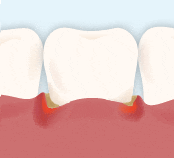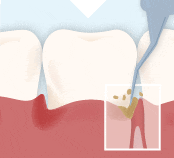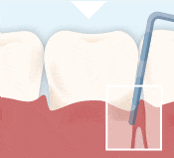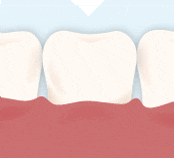

Treatment of the gums| Periodontology
When it comes to maintaining your teeth, periodontology represents a key discipline. Periodontology deals with the so-called periodontal apparatus or the structures which surround the teeth and fix them in the jaw (peri = around, odont = tooth).
In recent years, increasingly sophisticated methods have been developed to serve as dental prostheses. Nevertheless, for dentists, our highest priority is to do everything possible to ensure your natural teeth are retained. Because teeth are a natural wonder which should only be replaced in urgent cases.
What is periodontitis?
Periodontitis is a chronic bacterial infection of the gums or the periodontal apparatus. The periodontal apparatus includes the bone supporting the teeth, the periodontal membrane and the dental cement, among other aspects.
Untreated periodontitis can lead to teeth losing their footing and eventually completely falling out of their “foundations”. Usually, the bacteria multiply in so-called gingival pockets. Initially, those affected do not notice much at all of this development, which is why patients should attend regular prophylactic appointments.
Periodontitis is extremely widespread across Germany: almost 80% of the adult population suffers from periodontitis or from minor precursors of the disease.
Recognising periodontitis
As it is usually pain-free, periodontitis – as mentioned above – is often only noticed when it is too late. There are signs which point to the disease (e.g. bleeding gums, tooth migration). However, patients do not usually associate these signs with periodontitis.
For this reason, prevention plays an important role.
This includes, for example, measuring the depth of the gingival pockets and taking X-ray images in order to evaluate the condition of the jawbone.
Treatment methods
In recent years, periodontitis treatments have been continually further developed, meaning that their chances of success have significantly increased. The core of successful treatment is life-long control of the infection, allowing for the bacteria to be reduced to a minimum.
Long-term success can only occur when all potential “dirt recesses” have been eliminated.
This includes leaky fillings and wisdom teeth which cannot be maintained, among other things. In addition, the creation of an effective hygiene program to be used at home is part of the treatment.
Costs of periodontology
Statutory health insurance covers periodontology treatment according to the so-called efficiency rule (“sufficient, economical, appropriate”). In order for treatment to be carried out, the tooth in question must fulfill the periodontological requirements.
For teeth which have already been significantly weakened, statutory health insurance primarily stipulates removal (extraction). Before you choose removal, however, you should consider the fact that even weakened teeth can be maintained in the long-term with the appropriate treatment.
A dental prothesis is then not required. We will be pleased to support and advise you to make this decision. If treatment proves to be sensible, it will be privately billed according to the Scale of Fees for Dentists (GOZ).
Further services (e.g. periodontal pre-treatment, auxiliary periodontitis treatment, periodontal surgery) are generally not covered by statutory health insurance. In the case of private health insurance, depending on the policy or individual case, you may also be billed for a co-payment.
Of course, before treatment we will prepare a costs projection, tailored for you individually, which gives you detailed information regarding the individual items.
We will be happy to discuss the treatments or therapy which come into question for your case. Simply ask us for more information!
BERLIN SMILE DENTAL CENTRE
Your dentists in Berlin, right in Europacity
- Open Mo – Fr between 8am and 8pm
- (030) 95 99 99 410
- Heidestrasse 14, 10557 Berlin
- Parking spaces at the REWE opposite
- Our practice is fully accessible

What is periodontitis treatment like?

1. Hygienisation phase
In the first step, all the so-called dirt recesses in your teeth are closed. This includes, for example, leaky fillings or wisdom teeth which cannot be maintained. These area represent a breeding ground for bacteria – cleaning up these dirt recesses is therefore the highest priority.

2. Periodontal pre-treatment (PAV)
During periodontal pre-treatment (PAV), all teeth are initially thoroughly cleaned. Then, together with you we create a special dental hygiene program for you at home.
For thorough cleaning, 2-3 appointments are usually required. After cleaning, we measure the depth of the gingival pockets down to the millimeter with the help of so-called periodontal probes. Depending on the individual situation, we also take X-ray images in order to precisely visualize the status quo.
In severe cases, a bacteria test may also be carried out – this is entirely pain-free.

3. Periodontal treatment (PAB)
During periodontal treatment (PAB) itself, the surface of the roots under the edges of the gums are cleaned and polished.
Additionally, the often stubborn concretions are removed. If necessary, treatment may be supplemented with the prescription of special antibiotics.
Treatment takes place on two consecutive days under local anesthetic.

4. Periodontal follow-up (PAN)
After approximately 7 days, we check the course of healing on location in our dental practice Berlin Mitte – if necessary, the surfaces of the teeth are also polished.
5. Reevaluation with UPT
After approximately 10 weeks, a detailed evaluation of the periodontal status is carried out (comparison to initial situation before treatment).
Using a repeated measurement down the millimeter, we evaluate the treatment’s success.
After measurement, thorough subsequent cleaning is carried out, so-called “auxiliary periodontitis treatment ” (UPT).
6. Periodontal surgery
In rare cases, the deterioration of the bone has advanced to the extent that normal periodontitis treatment reaches its limits.
In these cases, periodontal surgery can be used.
Under certain conditions, it may be possible to regenerate the structure of the periodontal apparatus.
For this, special materials are used which serve as a replacement for the bone.
Periodontal surgery makes it possible for us to retain teeth which would in the past certainly have had to be removed.
7. Auxiliary periodontal treatment (UPT)
Periodontitis is a chronic disease. Periodontal treatment reduces the number of bacteria. So that this state can be maintained, the periodontal weaknesses must be consistently professionally checked or treated.
This takes place during auxiliary periodontal treatment (UPT). A UPT is significantly more extensive than professional dental cleaning (PZR). Alongside the UPT, you should also consistently carry out your dental hygiene program at home.
In the first year after periodontal treatment, UPTs should be carried out every three months. If the values remain stable, the UPT cycle can be extended in the second year to once every 6 months at the latest.
Is it worth it?
Yes, it is worth it, both financially and in terms of time.
During special training programs and our day-to-day work, we are able to recommend the treatment to everyone. It hinders the spread of periodontitis bacteria throughout the body and thereby also influences your overall state of health.
Without treatment, periodontitis bacteria can spread throughout the entire body. In various studies, these bacteria have been linked to pregnancy complications, diabetes and various cardiovascular diseases, among others.
Is it possible to retain all teeth?
Unfortunately, we cannot promise that it will be possible to retain all teeth. In spite of state-of-the-art treatment methods, it may be that the foundation of individual teeth have already been weakened too much and they cannot be retained. However, we will do our very best to retain as many natural teeth as possible.
Would you like to have periodontal treatment? We would be happy to answer your questions in an individual conversation. Contact us at any time.